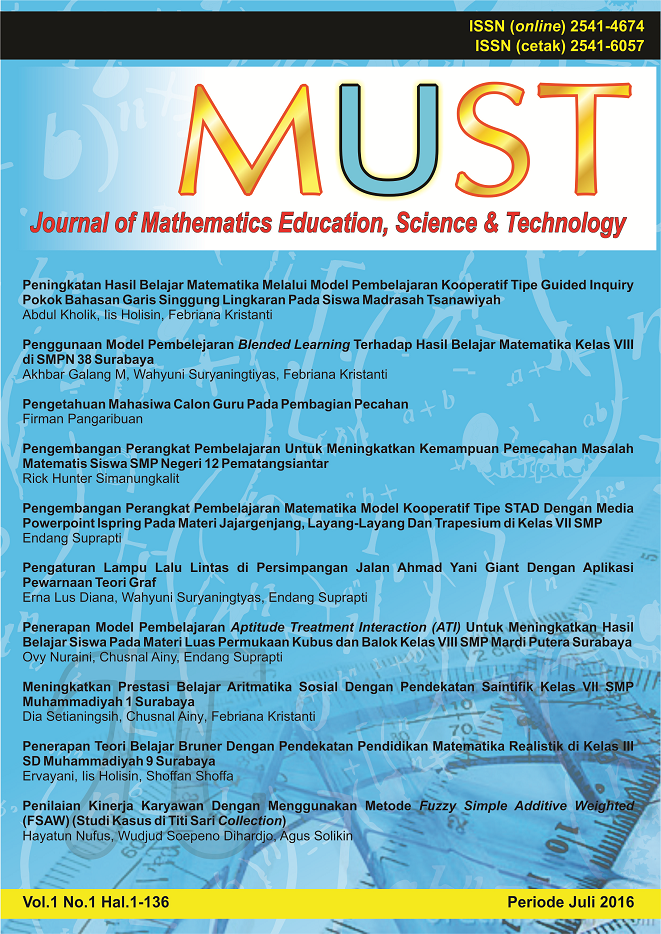Pengembangan Perangkat Pembelajaran Matematika Model Kooperatif Tipe STAD dengan Media Powerpoint Ispring pada Materi Jajargenjang, Layang-Layang dan Trapesium di Kelas VII SMP
Abstract
The aim of this research are: to describe the process of development and instructional instruments of cooperative learning type STAD with Microsoft Power Point Ispring on topic parallelogram, the kite and trapezium at SMP Class Seven. The Subject of this research is SMP Muhammadiyah 13 Surabaya in class seven at year 2013-2014, tow parallel class are VII A an VII B. The model of development teaching material for this research is use 4-D Thiagarajan’s development instructional model. The development process consist of four phases, those are define, design, develop, and disseminate. Instructional instruments that developed are lesson plan, students work sheet, achievement test and the microsoft power point ispring media learning. The researches instrument are used validation’s instructional instruments sheet, observational sheet of student’s activities in learning, observational sheet of teacher ability to manage the instruction, and the quotioner of students responses. The instructional instruments that has been developed by the next one will be seen whether already as instructional instruments that was good that is an equipment that could support learning process so as the aim that it was hoped could be reached and be equipment pembelajaran that was developed in accordance with the development procedure of instructional instruments and met (1) Valid that is has divalidasi by the expert and filled the minimal criterion valid. (2) was tested, by filling the criterion: (a) the teacher's capacity managed pembelajaran was classified as effective (b) the Activity of the student was classified as active (c) the positive Criterion for the student's response to pembelajaran and the completeness of studying results in a classical manner was reached (d) the results Test studied met valid, reliable and sensitive. Based on the analysis in the development stage, was received by the conclusion that instructional instruments cooperative model mathematics the STAD type with the media Microsoft PowerPoint Ispring learning to material parallelogram, the kite and the trapezium in the SMP Muhammadiyah 13 VII classes filled the good criterion was based on results of the validation of the expert and results of the test that filled conditions that were determined that is, (1) the activity of the student during pembelajaran effective; (2) the teacher's capacity in managed learning process effective; (3) the student's response to pembelajaran active and the completeness of studying results in a classical manner was reached; and (4) the results test studied that was used sensitive, valid, and reliabel.
Full text article
References
Arends, Richard I., 1997. Classroom Instruction and Management. McGraw-Hill.
Arikunto, Suharsimi. 2001. Dasar-dasar Evaluasi Pendidikan. Jakarta: Bumi Aksara.
----------, 2000. Manajemen Penelitian. Jakarta: Rineka Cipta.
Arsyad, Azhar. 2010. Media Pembelajaran. Jakarta: Rajawali Pers.
Didik Dwi Widodo, 2011, Pengembangan Perangkat Pembelajaran Kooperatif tipe STAD dengan Modul untuk pokok bahasan Sistem Persamaan Linier tiga Peubah, Tesis Tidak di Publikasikan. Surabaya: Program Pasca Sarjana Universitas Negeri Surabaya.
HUdojo, Herman, 1988. Mengajar Belajar Matenatika. Jakarta: Departemen Pendidikan Nasional
Ibrahim, Muslimin, dkk. 2000. Pembejaran Kooperatif, University Press. Universitas Negeri Surabaya
Isjoni, 2007. Pembelajaran Kooperatif. Yogyakarta: Pustaka Pelajar.
Khabibah, Siti, 2006. Pengembangan Model Pembelajaran Matematika dengan soal terbuka untuk meningkatkan kreatifitas siswa sekolah Dasar. Disertasi, Tidak di Publikasikan. Surabaya: Program Pasca Sarjana Universitas Negeri Surabaya.
Mulyasa E, 2007, Standar Kompetensi dan Sertifikasi Guru, Bandung: PT. Rosda Karya
Munadi, Yudhi, 2008, Media Pembelajaran, Jakarta: Gaung Persada
Nur, M. 2005. Pembelajaran Kooperatif. Surabaya: UNESA University Press
Pribadi, Benny A, 2009. Model Disain Sistem Pembelajaran, Jakarta: Dian Rakyat
Ratumanan, Tanwey G, 2004, Belajar dan Pembelajaran, Surabaya: UNESA University Press
Riyanto Yatim, 2005. Paradigma Pembelajaran. Surabaya: UNESA University Press
---------, 2006. Pengembangan Kurikulum dan Seputar Kurikulum Tingkat Satuan Pendidikan. Surabaya: UNESA University Press
Sadiman Arief S, dkk. 2009. Media Pendidikan, Jakarta: PT GRafindo Persada
Sagala saiful, 2009. Konsep dan Makna Pembelajaran. Bandung: Alfabeta.
Sistem Informasi UKDW, 2005. Tutorial Microsoft PowerPoint, www2.ukdw.ac.id/kuliah/si/SI4012/materi/pp.pdf diaccess tanggal 22 Juli 2014, Pukul 21.15
Slavin, Robert E. 2009. Cooperative Learning. Bandung: Nusa Media
Slavin, R.E, 1994. Educational Psychology Theory Into Practices (Fourth Edition). Boston: Allyn and Bacon
Soedjadi R 2000, Kiat Pendidikan Matematika di Indonesia. Jakarta: Departemen Pendidikan Nasional
Thiagarajan, S., Semmel, D.S., dan Semmel, M.I. 1974. Intructional Development for Training Teachers of Exceptional Children. Minnesota: University of Minnesota.
Trianto. 2007. Model-model Pembelajaran Inovatif Berorientasi Konstruktivistik. Jakarta: Prestasi Pustaka.
Veronita Libra Kusumawati, Enny, 2012, Pengembangan Perangkat Pembelajaran Kooperatif tipe STAD untuk materi Barisan dan Deret Kelas IX SMK Negeri 4 Surabaya, Tesis Tidak di Publikasikan. Surabaya: Program Pasca Sarjana Universitas Negeri Surabaya.
Yamasari, Yuni, 2010. Pengembangan Media Pembelajaran Matematika Berbasis ICT yang berkualitas. Seminar Nasional Pasca Sarjana X-ITS, Surabaya 4 Agustus 2010, ISBN No. 979-545-0270-1.
Authors
Authors who publish with this journal agree to the following terms:
- Authors retain copyright and grant the journal right of first publication with the work simultaneously licensed under a Creative Commons Attribution-NonCommercial 4.0 International License that allows others to share the work with an acknowledgment of the work's authorship and initial publication in this journal.
- Authors are able to enter into separate, additional contractual arrangements for the non-exclusive distribution of the journal's published version of the work (e.g., post it to an institutional repository or publish it in a book), with an acknowledgment of its initial publication in this journal.
- Authors are permitted and encouraged to post their work online (e.g., in institutional repositories or on their website) prior to and during the submission process, as it can lead to productive exchanges, as well as earlier and greater citation of published work

